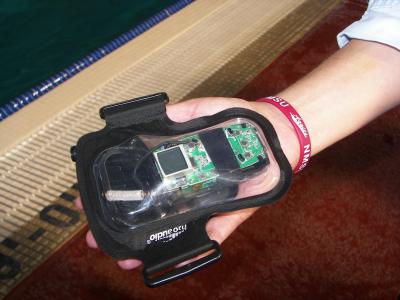Students build swimming aid for sight-impaired swimmers

Four electrical engineering students under the guidance of Professor Steven Stochaj are researching the project, which fulfills the capstone project requirement for engineering seniors.
"Dr. Stochaj had the idea, and I wrote the proposal detailing a preliminary design for the system," said Kenneth Stevens, lead engineer. "We have already tested the device in the pool, with excellent results meeting our expectations."
The device is a receiver that uses audio tones to indicate positions to swimmers, steering them toward the end of the pool and signifying when they venture too far left or right.
"We used a modified webcam to capture frames and process the images to filter the color of the object (the swimmer) and track its position," Stevens explained. "The filtering allows us to adjust the color to be recognized and tracked by the software to determine the swimmer's position. The position is related to a set of pre-drawn boundaries in the display, and an audio tone is generated. The tone is sent to the swimmer via radio communication. The swimmer hears the signal through a receiver, contained in a waterproof case. He also uses waterproof earphones to react appropriately to the audio warning signals."
Stevens and his teammates, Amy Garduno, Gabriel Madrid and John Watson, all electrical engineering seniors, presented the swimming aid to Stochaj and instructors Robert Hull and Krist Petersen at the NMSU Natatorium on June 29.
Wearing dark goggles through which he could see nothing but blackness, Watson demonstrated the aid in the swimming pool, while the other team members set up their equipment and explained their progress and developments.
Before settling on an FM receiver, the students debated the effectiveness of using other methods to develop their idea.
"This is the best one we came up with," said Watson, adding that other solutions included a magnetic water system and a path of bubbles to guide swimmers through lanes. "It's a great device. It weighs less than a quarter of a pound, and the communication system works to four feet, and the tracking system to a depth of two feet under the surface of water. We had to use lower radio frequencies for underwater."
Once the equipment has been set up, it runs on its own. There doesn't need to be anyone on the computer end to send signals to the receiver (swimmer).
According to Garduno, learning to recognize what each sound signifies doesn't take too long, but like any new operation, does require training.
"It's just a matter of getting used to which tone is which," said Madrid. "I don't think it would take very long."
To improve the aid, students said they would like to develop it to function deeper underwater. They also would like to market the device to organizations, so that it can actually assist sight-impaired swimmers.
The current estimated cost is less than $2,000, but Watson said they would like to be able to lower that to about $700.
Stochaj suggested to the students that they learn about patents from professionals at Arrowhead Center from NMSU's College of Business.
"This device is marketable, so they need to know about their rights to protect intellectual property," he said. "They got in contact with someone from Arrowhead right away."
Another feature that the group would eventually like to include is an additional tone to indicate to swimmers when they've reached the end of the lane. The current tool used is a tapper, a pole with soft ends.
Finally, Garduno said, the students hope to develop the swimming aid to assist more than one swimmer at a time.
"I'm sure in the future they could set it up to have one system for multiple swimmers," she said. "At this point, we'd need multiple systems."


